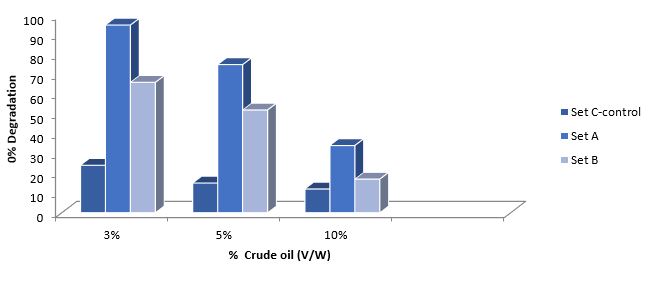Post-Reclamation Evaluation of Residual Hydrocarbons in Crude Oil Contaminated Soil Using Gas Chromatographic Techniques and Plant Growth Indices
DOI:
https://doi.org/10.54117/jpmesc.v2i1.5Keywords:
Bioremediation, Plant growth index, Crude Oil, Pollution, Phaseolus vulgaris, Glycine maxAbstract
The present study was undertaken to evaluate the post-reclamation of crude oil-contaminated soil using gas chromatographic technique and plant growth indices. Enrichment techniques, turbidometric test, plasmid curing test, classical identification method, gas chromatographic flame ionization detection technique and plant growth indices were carried out using standard procedures. The results indicated that 22 of the isolates were observed to have high pollutant degrading potentials (A600nm > 0.3) due to their crude oil utilization ability. The results also indicated that isolates which were able to degrade crude oil belonged to genera Bacillus, Pseudomanas sp., Ochrobacterium sp. and Enterobacter sp. Moreso, the remediation percentages recorded were 98 %, 80 %, 21 % and 98 %, 78 % and 22 % for the respective crude oil pollution (3 %, 5 % and 10 %) for soil inoculated plasmid borne bacteria whereas soil inoculated with plasmid cured bacterial cultures had 65 %, 52 %, 11 % and 65 %, 50 % and 20 % degradation of the same concentration of the total petroleum hydrocarbon after 60 days for both Phaseolus vulgaris and Glycine max plant seeds, respectively. The remediation percentages in the uninoculated controls include 3 %, 5 %, 10 % and 12 %, 9 % and 5 % across the pollutions for both plant seeds. A significant (P < 0.05) increase in the growth parameters of the leguminous plants like percentage germination, mean plant shoot length, mean plant root length, plant fresh weight and number of root nodules were seen more in the soil microcosms inoculated with plasmid-borne bacteria than microcosm inoculated with culture of plasmid cured bacteria across all crude oil dilutions. Crude oil had a dose-dependent negative effect on the mean bacterial counts of each of the polluted soil containing the two different plants. Thus, the study clearly suggests that the selected hydrocarbon bacterial degraders could be effectively exploited in the remediation of crude oil-polluted sites.

Downloads
Published
How to Cite
Issue
Section
License
Copyright (c) 2023 Chikelue M. Ifediegwu, Bright O. Uba, Ginika A. Awari, Anulika G. Chukwujekwu, Ifeanyi P. Akaun

This work is licensed under a Creative Commons Attribution 4.0 International License.
